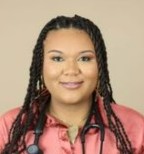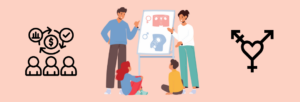Authors: Meghan Etsey MS3, Laura Uricoechea MS4, Brianna Clark, DO, MPH, CNPM, IBCLC on behalf of the AMWA Gender Equity Task Force
Access to reproductive health services is a fundamental right. Yet many individuals around the world—including in the United States—face barriers that limit their access to reproductive health education and care. These obstacles undermine personal autonomy and prevent people from making informed decisions about their health and futures. Gender inequality in healthcare stems from structural factors, including cultural norms, laws, policies, systems of governance, and educational and economic institutions that create systemic disadvantages. These inequities often intersect with factors such as gender, sexual orientation, race, and socioeconomic status, further compounding barriers to care. One of the most significant challenges in this context is the gendered approach to reproductive health services, which often fails to account for the diverse needs of all individuals. For instance, women’s reproductive health needs, particularly concerning contraception, maternal health, and abortion services, are often marginalized or stigmatized in many countries. This bias is especially prevalent in regions where conservative societal norms restrict women’s roles to motherhood and caregiving, limiting their access to reproductive care.
Studies have shown that in many low- and middle-income countries, women face financial and logistical obstacles when attempting to access reproductive health services. For example, a 2020 study found that one in four women in sub-Saharan Africa reported unmet needs for family planning services (UNFPA, 2020). These obstacles are often exacerbated by a lack of healthcare infrastructure and the limited availability of trained healthcare professionals, particularly in rural areas where women face even greater challenges accessing care. Barriers to reproductive care also exist in high-income countries. In the United States, for example, restrictive policies at both the state and federal levels limit access to essential services such as abortion, contraception, and comprehensive reproductive counseling (Fuentes, 2023; Friedrich-Karnik, 2024).
Additionally, gender-based violence (GBV) plays a significant role in reproductive health disparities. Women who experience intimate partner violence or sexual assault often face difficulties accessing reproductive health services, including sexual and reproductive health counseling and contraception. These barriers may stem from partner control over decision-making, such as sabotaging birth control or pressuring a woman to become pregnant or terminate a pregnancy against her will (American College of Obstetricians and Gynecologists, 2013). A report from the World Health Organization (WHO, 2017) highlighted that nearly one in three women worldwide has experienced physical or sexual violence in their lifetime. The barriers experienced by women affected by intimate partner violence can undermine their autonomy and contribute to poor physical and mental health outcomes (Campbell, 2002).
Education is also a critical component of reproductive health, as it empowers individuals to make informed decisions about their bodies and health. However, gender bias in reproductive health education perpetuates harmful stereotypes and limits access to accurate and comprehensive information. In many educational systems, reproductive health is taught primarily from a heteronormative and cisgender perspective, which excludes the experiences of transgender, non-binary, and gender non-conforming individuals (Rabbitte 2020). This exclusion results in these groups being underserved in terms of access to education on sexual and reproductive health.
The absence of comprehensive reproductive health education in many parts of the world remains a critical public health concern. According to the United Nations Population Fund (UNFPA, 2019), nearly 60% of young people in developing countries lack access to comprehensive sexuality education (CSE)—a curriculum that includes essential information about contraceptive methods, sexually transmitted infections (STIs), sexual consent, and sexual orientation. In the United States, the situation is equally troubling due to continued federal investment in abstinence-only-until-marriage programs, which have been repeatedly shown to be ineffective and harmful. Each year, the federal government allocates approximately $110 million to these programs—now rebranded as “sexual risk avoidance”—despite extensive evidence that they do not reduce rates of pregnancy, HIV, or other STIs in adolescents (Guttmacher, 2021).
These programs are not only misleading but dangerous. They systematically exclude critical information young people need to protect their health and make informed decisions. For example, grantees under the Title V Sexual Risk Avoidance Education (SRAE) program are permitted to mention contraception but prohibited from demonstrating how to use it. As a result, students often leave these programs without basic knowledge of how to prevent pregnancy or STIs. Abstinence-only curricula also relies heavily on judgment, shame, and fear tactics, reinforcing gender stereotypes and excluding lesbian, gay, bisexual, transgender, queer or questioning (LGBTQ+) youth from relevant, affirming education. This failure to provide inclusive and medically accurate information contributes to stigma, misinformation, and poor health outcomes—including higher rates of unintended pregnancy, HPV, and nonmarital births, especially in states that prioritize abstinence-based instruction (Guttmacher, 2021).
Addressing gender bias and inequality in reproductive health requires a multifaceted approach that focuses on both systemic change and community-level engagement. Policymakers must prioritize gender equality in health policies, ensuring that reproductive health services are accessible to all individuals, regardless of gender, sexual orientation, race, citizenship status, or socioeconomic status. Increasing funding for family planning services, improving healthcare infrastructure, and training healthcare providers to recognize and combat gender bias are crucial steps in addressing these disparities. Furthermore, educational curricula must be updated to include comprehensive, gender-inclusive sexual and reproductive health education that reflects the experiences and needs of all individuals. By providing accurate, inclusive, and non-stigmatizing information, we can empower individuals to make informed choices about their reproductive health and challenge harmful stereotypes. When individuals are equipped with knowledge about contraception, consent, and their reproductive rights—and have reliable access to affordable contraceptive methods—they are better able to prevent unintended pregnancies. As a result, the need for abortions, particularly those sought in crisis or unsafe conditions, is significantly reduced (Peipert et. al., 2012). Comprehensive care and education not only support reproductive autonomy but also serve as powerful tools in reducing abortion rates by preventing the circumstances that often lead to them.
Lastly, global movements advocating for gender equality, such as the United Nations’ Sustainable Development Goal 5 (gender equality) and the International Conference on Population and Development (ICPD) Programme of Action, have called for the elimination of barriers to reproductive health and education. Continued advocacy for the rights of marginalized groups, including women, transgender, and non-binary individuals, is necessary to dismantle the structures of gender-based inequality that persist in reproductive health systems.
Gender inequality remains a major barrier to accessing reproductive health services and education worldwide. Gender bias, cultural norms, lack of resources, and systemic discrimination continue to limit opportunities for women and marginalized groups to receive the reproductive care and education they deserve. It is imperative that we address these disparities through policy changes, comprehensive education, and social advocacy, ensuring that reproductive health becomes a universal right that is accessible to all, irrespective of gender.
References
- American College of Obstetricians and Gynecologists. (2013). ACOG Committee opinion no. 554: Reproductive and Sexual Coercion. Obstetrics and Gynecology, 121(2 Pt 1), 411–415. https://doi.org/10.1097/01.AOG.0000426427.79586.3b
- Campbell, J. (2002). Health consequences of intimate partner violence. The Lancet, 359(9314), 1331–1336. https://doi.org/10.1016/S0140-6736(02)08336-8
- Fuentes, L. (2023, January). Inequity in US Abortion Rights and Access: The End of Roe Is Deepening Existing Divides. The Guttmacher Institute. https://www.guttmacher.org/2023/01/inequity-us-abortion-rights-and-access-end-roe-deepening-existing-divides
- Friedrich-Karnik. (2024, August). Restricting Title X Results in Cascading Harms (Amy, Trans.). Guttmacher Institute. https://www.guttmacher.org/2024/08/restricting-title-x-results-cascading-harms?utm_source=chatgpt.com
- Guttmacher Institute. (2021, May). Federally funded abstinence-only programs: Harmful and ineffective (Federal Policy Snapshots series). https://www.guttmacher.org/fact-sheet/abstinence-only-programs
- Peipert, J. F., Madden, T., Allsworth, J. E., & Secura, G. M. (2012). Preventing unintended pregnancies by providing no-cost contraception. Obstetrics & Gynecology, 120(6), 1291–1297. https://doi.org/10.1097/AOG.0b013e318273eb56
- Rabbitte, M. (2020). Sex education in school, are gender and sexual minority youth included?: A decade in review. American Journal of Sexuality Education, 15(4), 530–542. https://doi.org/10.1080/15546128.2020.1832009
- Solar, O., & Irwin, A. (2007). A Conceptual Framework for Action on the Social Determinants of Health. Digital Repository at the University of Maryland. https://doi.org/10.13016/etou-fdmv
- United Nations Population Fund. (2019). State of World Population 2019: Unfinished business – the pursuit of rights and choices for all. UNFPA.
- United Nations Population Fund. (2020). Family planning: Key to achieving the sustainable development goals. UNFPA.
- World Health Organization. (2017). Violence against women prevalence estimates, 2018. WHO.
- World Health Organization. (2020). Sexual and reproductive health. WHO.
- Contraceptive Deserts 2025 | Power to Decide. (n.d.). Retrieved April 3, 2025, from https://powertodecide.org/what-we-do/contraceptive-deserts
About the Authors
 Meghan Etsey, MS3 is a third year medical student from St. George’s University. She has a Bachelors of Arts in Biology and a Bachelors of Arts in Nutrition and Dietetics from Bluffton University in Bluffton, Ohio. She served as the President of the St. George’s University’s Women in Medicine chapter in St. George, Grenada where she expanded relationships with the community and worked towards educating women and helping the youth. She is also a member of the Gender Equity Task Force and Sex and Gender Health Collaborative Committees within the American Medical Women’s Association. When she is not pursuing medicine, you can find her with her friends and family on different road trips and adventures exploring the world.
Meghan Etsey, MS3 is a third year medical student from St. George’s University. She has a Bachelors of Arts in Biology and a Bachelors of Arts in Nutrition and Dietetics from Bluffton University in Bluffton, Ohio. She served as the President of the St. George’s University’s Women in Medicine chapter in St. George, Grenada where she expanded relationships with the community and worked towards educating women and helping the youth. She is also a member of the Gender Equity Task Force and Sex and Gender Health Collaborative Committees within the American Medical Women’s Association. When she is not pursuing medicine, you can find her with her friends and family on different road trips and adventures exploring the world.
 Laura Uricoechea, MS4
Laura Uricoechea, MS4
Laura Uricoechea is a fourth-year medical student at the Philadelphia College of Osteopathic Medicine. She is currently completing a Master of Public Health at Thomas Jefferson University between her third and fourth years of medical school. Laura is applying to OB/GYN residency and is passionate about women’s health, particularly reproductive healthcare. She is an active member of the Gender Equity Task Force within the American Medical Women’s Association. Outside of medicine, Laura enjoys spending time outdoors—she loves hiking, paddleboarding, swimming, and playing tennis.
 Dr. Brianna Clark is a proud osteopathic physician. She has completed fellowships in Breastfeeding Medicine at the University of Rochester Lessons in Lactation Advanced Curriculum ( LILAC) and Climate Health Equity Fellowship ( CHEF) through the National Medical Association ( NMA). She spends her spare time thinking about innovative ways to provide equitable health care to all and create sustainable advocacy.
Dr. Brianna Clark is a proud osteopathic physician. She has completed fellowships in Breastfeeding Medicine at the University of Rochester Lessons in Lactation Advanced Curriculum ( LILAC) and Climate Health Equity Fellowship ( CHEF) through the National Medical Association ( NMA). She spends her spare time thinking about innovative ways to provide equitable health care to all and create sustainable advocacy.
